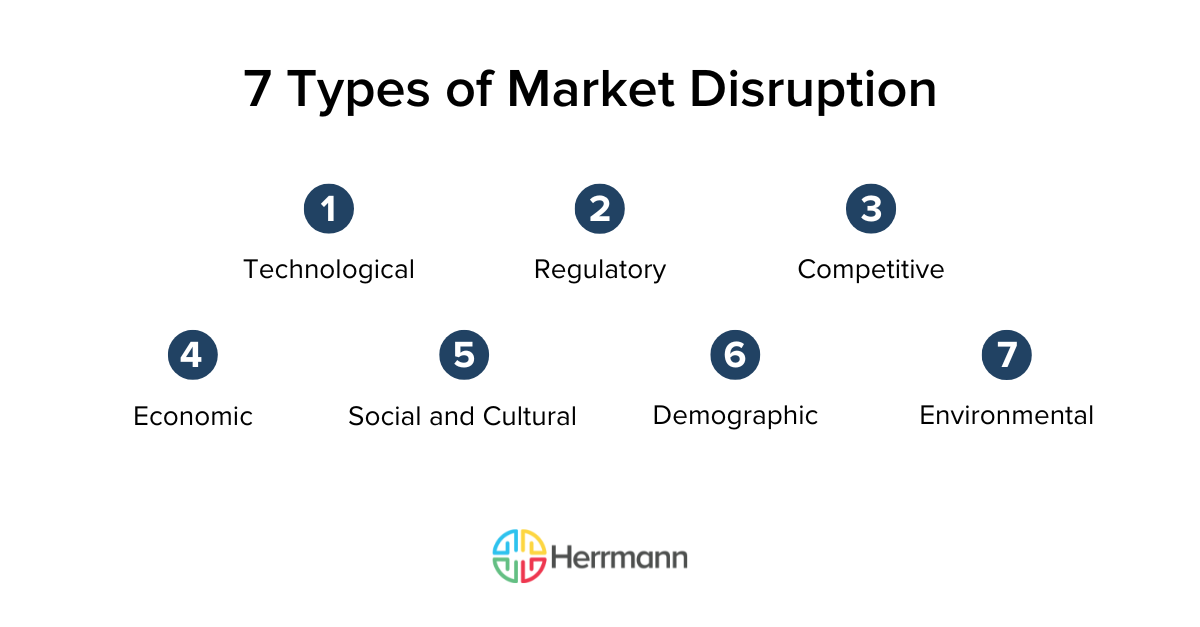Market disruption is an unavoidable fact of life for businesses. Your business model will eventually face disruption, whether that disruption comes from black swan events, economic headwinds, regulatory pressures, new competitors, changing customer habits, or internal miscues.
Even the biggest companies have become more vulnerable to disruption in recent decades amid globalization and rapid technological advances. The tenure of the average Standard & Poor’s 500 company was 21 years in 2020, down from 32 years in 1965. Meanwhile, only 54 Fortune 500 companies made that list continuously from 1955 to 2018. The current No. 1 company by revenue, Walmart, didn’t even exist until 1962.
Fortunately, market disruption doesn’t mean doom. Learn about the definition of disruption, how it manifests, and how leaders can turn disruption into an opportunity to capture new markets. We’ll also show how Whole Brain® Thinking helps individuals, teams, and organizations unlock the collaboration and cognitive diversity required to innovate in the face of market disruption.
What Is Market Disruption?
Market disruption is any significant change or disturbance in an industry or market that alters existing business models, practices, and dynamics. Disruption, by definition, entails large-scale changes that are difficult or impossible to undo. Disruption requires businesses to adapt, innovate, and find new ways to deliver customer value.
Market disruption has many potential causes. Here are some of them.
7 Types of Market Disruption
- Technological disruption: This occurs when new technologies or innovations significantly change how products or services are produced, distributed, or consumed. Examples include flight, the rise of the internet and e-commerce, streaming services, and ride-sharing platforms.
- Regulatory disruption: Changes in government regulations or policies can disrupt the status quo, especially when industries suddenly become more regulated. Airbnb, for example, saw its ability to operate in New York City disrupted by a local ordinance.
- Competitive disruption: This type of disruption comes from new entrants, such as direct competitors who can offer lower prices, superior products, or more innovative business models. Industry disruption can also occur from indirect competitors whose products or services suddenly undercut or displace a company’s offerings. Weight-loss drugs, for example, could disrupt consumption-based industries, even though they aren’t direct competitors.
- Economic disruption: Economic factors such as recession or inflation can disrupt markets by altering demand, supply chains, and market dynamics.
- Social and cultural disruption: Changes in societal attitudes, preferences, or cultural norms can disrupt markets. COVID-19 pandemic restrictions and rising consumer demand for sustainable and eco-friendly products are two examples of social disruption.
- Demographic disruption: Shifts in demographics, such as changes in population size, age distribution, or income levels, can create market disruption. Aging populations, for example, can disrupt industries that cater to younger audiences but be a boon to other sectors, such as elder care.
- Environmental disruption: Environmental factors, including natural disasters, climate change, and resource scarcity, can disrupt markets. Industries like agriculture, insurance, and renewable energy are particularly susceptible to such disruptions.
Disruptive Innovation (The Innovator’s Dilemma)
Disruptive innovation, popularized by Clayton Christensen in his book “The Innovator’s Dilemma,” describes a dilemma of good management at companies.
Incumbents commonly spot cutting-edge trends or technologies — they might even pioneer them. But they might follow through because the initial opportunity or profit potential is insignificant or because they can’t justify disrupting their currently successful business. What makes them successful incumbents also causes them to miss these opportunities.
They leave these markets to upstarts that initially don’t pose a threat — and many never do. But the ones that succeed eventually scale rapidly and disrupt incumbents.

The 5 Stages of Market Disruption
One way to think about market disruption is through five distinct stages. This sequence starts pre-disruption and follows market players through to the next normal. Here are those five stages described by Dr. Jay Chopra of Making Shift Happen and Damian Costello of Decode Innovation.
Stage 1: Normal
Market leaders in this stage sit in a mature, stable market. They focus on doing more of what they do well rather than how well they serve the customers. Other players notice this disconnect and start niche businesses (or pivot existing businesses) to serve subsets of the market better. While the normal stage persists, the newcomers pose little threat to the market share or profitability of the established leaders.
Stage 2: The Event
Things remain stable until an event triggers the disruption — a new technology, a new law or regulation, or a shift in public sentiment toward the market leaders. Incumbents tend to underestimate or even ridicule the significance of these events. A famous example is longtime movie studio head Darryl Zanuck, who in 1946 said about an emerging technology: “Television won't last because people will soon get tired of staring at a plywood box every night.”
Stage 3: Crisis
Only when the event seriously affects the bottom line will market leaders realize the significance. But with a limited understanding of the larger context, they can draw the wrong conclusions. For example, they might invest in incremental or remedial solutions that lose money and time.
Stage 4: Confusion
This stage is marked by confusion in the marketplace — and potentially within leading organizations. The disrupted market leaders might shore up old offerings while simultaneously trying to release new ones — potentially falling short on both fronts. Employees, consumers, and investors might struggle to understand what’s happening or what they should do.
Meanwhile, the emerging force is far from a finished product, but that doesn’t stop a clamor to invest, experiment, and jockey for position. Speculators make early investments based on immature best guesses or by faking it till they make it. Amid all this noise, the voice of the cautious, reputable market leaders can get drowned out.
Stage 5: New Normal
The new reality is here, likely with new market leaders and many incumbents and early speculators alike having crashed and burned. A few will learn enough valuable lessons and evolve to take a lesser place in the new market.
4 Outcomes of Market Disruption
In this model, there are four possible endings for market leaders facing disruption:
- Extinction: The crisis kills off your business before you can respond effectively, if at all.
- Interruption: After temporary pain, your business returns to normal.
- Disruption loser: The crisis triggers irreversible changes to market conditions that greatly weaken your company’s position.
- Disruption winner: The crisis triggers changes to market conditions that greatly strengthen your company’s position.
How Whole Brain® Thinking Can Help You Navigate Market Disruption
Whole Brain® Thinking provides a framework for understanding and harnessing different thinking preferences to drive better thinking, performance, and results. People who have taken the Herrmann Brain Dominance Instrument® (HBDI®) assessment can see their thinking style preferences through Whole Brain Thinking’s four quadrants: Analytical (Blue), Structural/Practical (Green), Relational (Red), And Experimental/Innovative (Yellow).
Analytical thinking is logical and focused on problem-solving, while practical thinking is grounded and efficient in planning and action. Relational thinking emphasizes interpersonal skills and collaboration, while innovative thinking emphasizes creativity and big-picture thinking. While people prefer using one or two quadrants, we have the capability and ability to use all four in our day-to-day lives.
At the team and organizational levels, Whole Brain® Thinking helps people understand their thinking and their colleagues’ thinking — and embrace the cognitive diversity of many preferences and approaches. This ability to consider multiple perspectives, avoid groupthink, and stretch beyond personal boundaries is essential for companies during disruption. If the old ways aren’t working, teams need the capacity and courage to explore alternatives
Whole Brain® Thinking is well-suited for managing the threat of business disruption. Here’s how to think about this framework at each stage of disruption using the example of the automotive industry as electric vehicles emerged.
Seeing the 5 Stages of Market Disruption Through Whole Brain® Thinking
Stage 1: Normal
Leading automakers long focused on producing and selling gasoline-powered vehicles through standardized, efficient processes for product design, supply chain, manufacturing, and sales. Their scale and brand reputations are powerful inhibitors to new entrants. These companies are embracing Analytical (Blue) and Structural (Green) thinking but not exercising their muscles in Experimental (Yellow) thinking or thinking deeply about what else customers might want (Relational/Red).
Now, niche businesses have popped up, focusing on hybrid or electric vehicles (EVs). Some legacy automakers are also researching these concepts, but there’s little initial threat to market leaders. Companies exploring EVs at this stage are highly Experimental (Yellow), with some being motivated by Relational (Red) factors, such as environmental concerns.
Stage 2: The Event
At some point, an event happens (or several events) that catapults EVs to a real threat and alternative. These events include the emergence of advanced EV technology, early success of hybrid and EV models, strong emerging entrants such as Tesla, and increasing concerns about environmental sustainability.
However, many market leaders continue to underestimate or even ridicule the significance of EVs and their market entrants. They might believe that customers won’t embrace EVs, that the technology is immature, or that the required supply chains and infrastructure won’t get built. While correct that EVs are not yet a dominant force, this is an overreliance on Blue thinking at the expense of the big picture (Yellow) and changing consumer sentiments (Red).
Meanwhile, many early EV entrants will struggle if they fail to advance the technology (Yellow), lack the discipline to see through early struggles (Green), or fail to create a path to profitability (Blue).
Stage 3: Crisis
Only when the results of the event or events begin to seriously impact automakers’ profit, market share, and reputation do many market leaders wake up to the significance. They might make the wrong choices in a hasty response, such as doubling down on gasoline-powered vehicles, dismissing EVs as a fad, or making ill-conceived efforts to develop their own EVs without the right expertise or resources.
The crisis stage highlights why every quadrant of Whole Brain® Thinking is needed to navigate disruption effectively. Market leaders who over-rely on established methods (Blue) will fail to be innovative or understand customer needs. Likewise, market leaders who rush to build their own EVs (Yellow) without proper planning (Green) or financial analysis (Blue) can further hurt their financial position, confuse consumers, and demoralize employees (Red).
Navigating this crucial stage requires combining daring experimentation (Yellow) with a firm understanding of the emerging business model (Blue), a plan for balancing both sides of the business (Green), and the right mix of internal talent and external partnerships (Red).
Stage 4: Confusion
This stage is marked by confusion in the marketplace as consumers and investors struggle to know what to do. Established automakers might try to shore up their gasoline-powered offerings or struggle to integrate EV design and production into existing structures. Meanwhile, some EV manufacturers go to market too soon and fail. Others take on massive amounts of investor backing even before they have a viable product. Additionally, regulators begin to get involved, sometimes by setting strict environmental standards that incentivize new entrants, other times by erecting barriers that protect incumbents.
During the confusion stage, Whole Brain® Thinking can help market leaders make informed decisions. Automakers are still the best at understanding market dynamics, producing and marketing vehicles (Blue), and planning production processes and supply chains (Green). They also have considerable access to capital and credit to fuel sound bets (Yellow), collaborate with nascent EV manufacturers (Red), and communicate their new market positioning to consumers.
Stage 5: New Normal
By this stage, the automobile industry has transformed, and EVs have become the new normal, both in terms of production and consumer expectations. The market leaders who failed to adapt to the disruption have lost market share to new entrants and some incumbents. Companies that embraced EV technology and had sound business models have thrived. Others had mixed success. They now occupy smaller market positions, have pivoted to other businesses, or were acquired.
In this transformed market, Whole Brain® Thinking remains valuable to understanding the new normal (Blue), planning for further EV improvements (Green), scoping out additional EV-related services while monitoring for the next wave of threats (Yellow), and guiding consumers, suppliers, and other stakeholders as they get used to the new marketplace (Red).
.png?width=1200&height=627&name=%5BHG%5D%20InternalImageB_5%20Strategies%20for%20Turning%20Market%20Disruption%20Into%20New-Market%20Dominance%20(1).png)
5 Strategies for Turning Market Disruption Into New-Market Dominance
We live in a VUCA world, where change and disruption lurk around every corner. Every modern leader must know how to confront and capitalize on disruption. Here are five steps leaders can take.
Embrace a Growth Mindset
To turn market disruption into new-market dominance, businesses must embrace a growth mindset. Leaders should encourage their teams to view disruption as an opportunity for growth and transformation rather than a threat. This mindset shift sets the stage for innovation, adaptability, and resilience.
Foster a Culture of Innovation
Innovation is key to thriving in a disrupted market and goes hand in hand with a growth mindset. Not every old method should be discarded, but a culture that emphasizes “that’s not how it’s done” will fail to innovate — and will cover employees who dare to suggest new ways of thinking.
Managers have an important role in this process by fostering collaborative brainstorming. When teams trust each other to work through ideas collaboratively, they can take calculated risks with a business case, a timeline, and defined roles for all involved parties.
Anticipate and Adapt to Customer Needs
Sign up to our newsletter for the latest insights
Whole Brain® Thinking enables businesses to approach customer needs holistically. By leveraging analytical thinking, organizations can assess market trends and customer behaviors to identify emerging needs. Practical thinking helps translate these insights into actionable strategies and plans. Relational thinking fosters strong customer relationships and effective communication. Innovative thinking drives the creation of customer-centric solutions.
Embrace Technology and Digital Transformation
Responding to market disruption increasingly depends on embracing technological advances, whether those are artificial intelligence, new materials, or the latest software. Tech adoption, of course, isn’t enough — you also need a workforce that embraces transformation.
Whole Brain® Thinking can help organizations navigate the complexities of technology adoption and digital transformation. Experimental thinking can help companies find the most cutting-edge technologies and opportunities, while selecting the right technologies and implementing them requires analytical and structural thinking.
Finally, because transformation will fail without employee buy-in, leaders must embrace relational thinking through empathetic communication and thorough training.
Collaborate and Partner
In a disrupted market, collaboration and partnerships can help businesses pool their expertise, share risks and resources, and accelerate innovation and market gains.
Much like teams that have taken the HBDI® can understand and appreciate each other’s thinking preferences, collaboration with other companies, nonprofits, universities, and other organizations can unlock new ideas through different perspectives, experiences, and thinking.
Make Market Disruption Your New Beginning
While market disruption hits every industry at one time or another, smart companies and leaders know that disruption is also an opportunity. Disruption forces people to think differently, to seek other perspectives and opinions, and to try things they otherwise wouldn’t have. By understanding what causes disruptions and applying Whole Brain® Thinking to the challenge, you can avoid the fate of many fallen companies and turn market disruption into new-market dominance.












